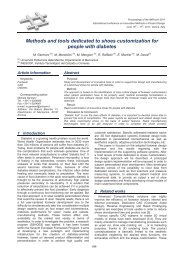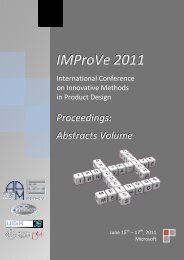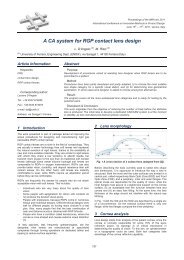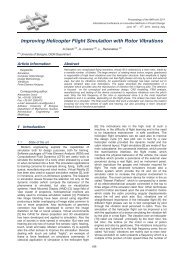IMProVe 2011 - Proceedings
IMProVe 2011 - Proceedings
IMProVe 2011 - Proceedings
Create successful ePaper yourself
Turn your PDF publications into a flip-book with our unique Google optimized e-Paper software.
Innovative Methods in Architectural Design<br />
Nevertheless, the virtual pads introduce a fundamental concept in drawing up plans or<br />
plan survey. But a problem exists, to access to the virtual graphical representation without<br />
the necessary maturity in the field of the Architectonic Presentation.<br />
We must think that independently of the used technique it is very important to know the<br />
aim a priori that is wanted to obtain, since this one is the only mean to obtain it. For that<br />
reason, a constructive understanding of the architectonic work is advisable, before<br />
realising any representation of it, and based on it, we will choose the more suitable<br />
technique of representation.<br />
It is for that reason that seems so important to us to make an analysis of the drawing up a<br />
building and its problems.<br />
From the Madrid Politecnic University, we must begin to stimulate the new forms to<br />
express the architecture, imaginary or constructed, and to express with a clear and<br />
concise language our work, so that we pruned to show from different points of view our<br />
finished work or process of creation.<br />
Consequently, we must try to balance the feeling of using such a powerful means for<br />
designing as those based on computing techniques with the intrinsic value of the graphic<br />
means based on the traditional manual ones. We consider it is the best approach for using<br />
the new technologies.<br />
Keywords: Innovative Methods in Design, Representation Systems, Geometric Analysis,<br />
Simulation and Virtual Approaches, Building information modeling<br />
Corresponding Author: Mercedes Valiente López<br />
Tel.: +34696782221<br />
Fax.: +34913367597<br />
e-mail: mercedes.valiente@upm.es<br />
Address: General Álvarez de Castro nº 23 - 28010 Madrid. Spain.<br />
Architecture = Design?<br />
The increasingly strong link between 3D modeling<br />
and automated manufacturing<br />
June 15 th – 17 th , <strong>2011</strong>, Venice, Italy<br />
M. Capone (a)<br />
(a) University of Naples Federico II, Architecture, DICATA<br />
Abstract:<br />
3D models have always been used to study and control complex shapes. The Luca Pacioli's<br />
vacuous models and Gaudi's funicular polygon are the best way to study geometry and to<br />
represent complex architecture. The 3D digital model offers advantages over the<br />
traditional material model, in fact it is able to simulate the perceptive dimension, to verify<br />
structures, but we can build from it, prototypes or architectural components too. The<br />
relationship between digital model and construction is very close, now we can produce<br />
169<br />
<strong>IMProVe</strong> <strong>2011</strong> - <strong>Proceedings</strong>










